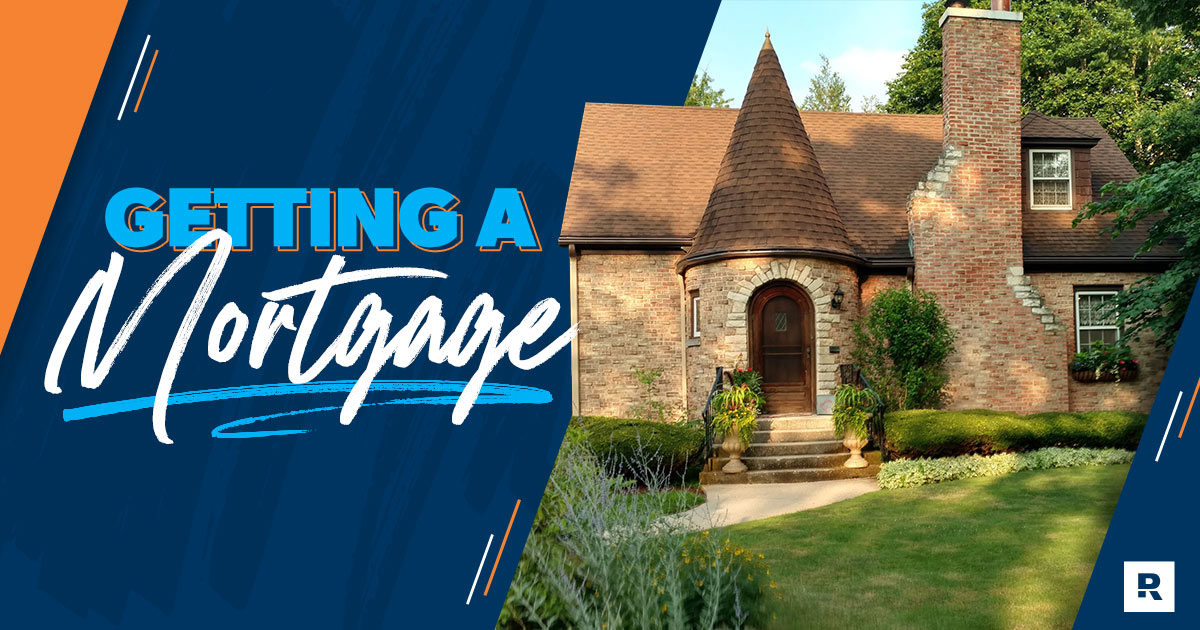
You finally found it. The house of your dreams (or at least the house you can afford). After months of Zillow doom scrolling, you found the perfect four walls with just the right amount of natural light. It even has a nice little backyard that won’t take too much maintenance, but is big enough for a firepit. You’ve got your down payment saved. All you need is . . .
A mortgage.
Sure, it’d be more fun to think about the color you want to paint the kitchen, but you need a mortgage if you want a kitchen to make over. Figuring out how to get a mortgage can sound intimidating—especially because there are a few ways to do it, and some aren’t so great.
But don’t worry. We’ll walk you through the process and show you the best way to do it so you can get back to deciding between Owl Grey and Fancy Pants for your new kitchen.
How to Get a Mortgage in 8 Steps
Here are the eight steps we’ll cover:
- Set Your Budget
- Assess Your Credit
- Get Preapproved
- Choose the Right Mortgage Type
- Decide on a Lender
- Submit Your Application
- Begin the Underwriting Process
- Close on the House
Before we break down those steps, you need to know something super important: Buying a house when you already have debt is a bad idea. Becoming a homeowner is exciting, but it’s also expensive—and you don’t want to spread your money too thin. It’s tough to foot that bill when you’re already making payments on student loans, credit cards or a car note.
You should also hold off on becoming a homeowner until you’ve built up an emergency fund of 3–6 months of your typical expenses. Unlike when you’re renting, you’ll be on the hook to pay for repairs whenever something breaks in a house you own—which is why an emergency fund makes a massive difference.
If you haven’t tackled those goals yet, be patient and start there. It’s okay to put the home-buying journey on pause until you’re financially ready! But if you are debt-free with an emergency fund, here’s how to get a mortgage.
1. Set Your Budget
Step one to getting a mortgage is setting your home budget. It’s important to start here, because lots of lenders will offer you a bigger loan than you can actually afford—and you’ll fall headfirst into that trap if you haven’t decided on a limit ahead of time.
So, how do you know where to set your home budget? Here’s a good rule of thumb: Your monthly house payment should be no more than 25% of your take-home pay. This includes principal, interest, and other costs like taxes, HOA fees and homeowners insurance.
That might not seem like a very big number, but spending more than that on a house is a recipe for a super tight budget. You want enough breathing room to comfortably cover your monthly expenses and have plenty of money left over to save for other important things, like retirement.
Once you set your budget, stick to it! And remember: It’s up to you to decide how much house you can afford, not mortgage companies.
Get the right mortgage from a trusted lender.
Whether you’re buying or refinancing, you can trust Churchill Mortgage to help you choose the best mortgage with a locked-in rate.
2. Assess Your Credit
As you probably could’ve guessed, lenders only want to loan money to people who are likely to pay it back. And most of them will go right to your credit score to see if you fit that bill. Typically, mortgage companies feel comfortable loaning money to folks with a FICO score of 620 or above.
But don’t think that means you need start working to build up your credit, because that’s not actually a good idea. See, the only way to get a good credit score is to borrow a lot of money over a long period of time. And like we talked about earlier, you definitely should not go into debt before buying a house.
Dave Ramsey recommends one mortgage company. This one!
Instead, find a mortgage company that offers a no-score loan through manual underwriting. Instead of simply looking at your credit score, the lender looks through payment records and documents—like rent payments, utility payments, and insurance payments—that prove you can pay back your mortgage.
To be eligible for manual underwriting, you’ll need to be debt-free with a zero credit score. If you currently have a low credit score, don’t worry! Start by paying off all your debt, then your credit score will eventually dwindle down to zero.
3. Get Preapproved
A mortgage preapproval happens when a lender looks at your finances—income, assets and credit history—and decides how much mortgage you can afford. When you get preapproved, sellers know you mean business because you’ve already started working with a lender—and a lender has agreed to work with you.
Once you start the preapproval process, you’ll discover how much lenders love documentation. They want everything—proof of income, assets and employment.
You’ll likely need to provide all these documents to get preapproved:
- Driver’s license or U.S. passport
- Social Security card or number
- Your paystub from the last 30 days
- W-2 forms and tax returns from the last two years
- Bank statements
- Last quarterly statement from your retirement or other investing accounts
Now, this list is just a starting point. Depending on your situation, you may need to send the lender even more documents.
Just know that you’ll have to jump through these hoops regardless of whether you decide to get preapproved, so it’s absolutely worth knocking it out on the front end.
4. Choose the Right Mortgage Type
The different mortgages you can choose from almost outnumber the entrée options in The Cheesecake Factory’s menu (which is over 20 pages long, by the way).
But unlike the The Cheesecake Factory, where it’s hard to go wrong, you’re better off avoiding most of the mortgages out there. Here’s a sneak peek at the worst types of mortgages:
- Adjustable-rate mortgages (ARMs): The whole premise of an ARM is that your mortgage rate is adjustable, which would be a great deal if it was guaranteed to decrease. Unfortunately, that’s not always what happens. More than likely, you’ll see an increase at some point during the life of the loan—potentially leaving you with a bigger monthly payment than you can afford.
- FHA loans: These mortgages are designed for people who want to make a tiny down payment—as low as 3.5%. But they’re full of fees, including an upfront Mortgage Insurance Premium (MIP) totaling 1.75% of your loan amount and an annual MIP—potentially for the life of the loan.1
- VA loans: Designed as a benefit for military veterans and their families, VA loans usually aren’t much of a “benefit” at all because of a pricey funding fee.
- USDA loans: You’ll need to move to a super rural area to even be eligible for a USDA loan. But even if it is an option, you should still avoid it. USDA loan repayment plans often lead to borrowers going underwater on their homes.
- 30-year conventional mortgages: While 30-year loans do offer smaller monthly payments than 15-year loans, they keep you in debt for a lot longer and force you to pay tens of thousands in extra interest.
So, what’s the right kind of home loan? A 15-year fixed-rate conventional mortgage. It’s a ticket to paying less interest and fewer fees while getting out of debt way faster!
5. Decide on a Lender
You don’t want just anyone loaning you money. You want someone who mentors you through the process, explains your mortgage options and gives clear answers.
To help you decide which mortgage company is right for you, ask a potential lender these key questions:
- How much time do you need for home appraisals, underwriting and closing?
- How do you prefer to communicate with your clients? Over the phone, email or text messaging?
- What fees will I pay at closing?
- Do you offer loan rate locks?
- Do you guarantee on-time closings?
- Can you perform manual underwriting?
A great place to start is talking with our friends at Churchill Mortgage. Their team will serve you with excellence, and they offer manual underwriting.
6. Submit Your Application
While a mortgage preapproval means you are probably going to get the loan, you still have to submit your application to a mortgage underwriter to get the final nod. Luckily, when you’ve already gone through the preapproval process, this part is easy!
Even if you don’t wind up using the same lender who gave you the mortgage preapproval, you’ll already have all the necessary documents at the ready so the new lender can quickly begin the application process.
7. Begin the Underwriting Process
Your lender will eventually pass the loan application to a mortgage underwriter who will take one last look at your documents to double-check that you’re financially ready for a mortgage. Yes, this will feel repetitive if you’ve already been preapproved, but it’s just part of the process—and some lenders even dig a little bit deeper this time around.
But mainly, your lender will make sure nothing major has changed with your finances since you got preapproved. So, to avoid throwing a wrench into this whole operation, don’t do any of the following once you get preapproved:
- Open a new line of credit
- Make an extremely large purchase
- Change jobs
- Fail to pay rent or monthly bills
Underwriting can take as short as three days or as long as three weeks, depending on the accuracy of your documents.
8. Close on the House
If the underwriter approves your application, you can finally breathe a sigh of relief. At this point, there should be no surprises. You’re getting a mortgage!
If you haven’t already, make sure you do these things before you close:
- Get homeowner’s insurance. Talk with an insurance agent at least a month before you plan to close on your house.
- Get title insurance. This insurance will protect you from any problems in your home’s title. Most lenders require it.
- Get a cashier’s check. This check is proof that you have the exact amount of down payment you said you’d pay. You will need to bring this on closing day when you sign your closing disclosure.
Once all the closing paperwork is signed by both you and seller, you’ll get the keys to your new house. Time to celebrate—and start choosing paint colors for your new kitchen!
Get a Mortgage the Right Way
If you’re looking for someone who will walk with you in the mortgage process every step of the way, check out Churchill Mortgage and talk to a home loan specialist.
The folks over at Churchill really know what they’re doing. They’ve been helping families get mortgages the right way for over two decades. So don’t wait! Contact a Churchill Loan Specialist today.
Did you find this article helpful? Share it!

We Hear You!
We’re considering adding the ability to save articles to your Ramsey account.




